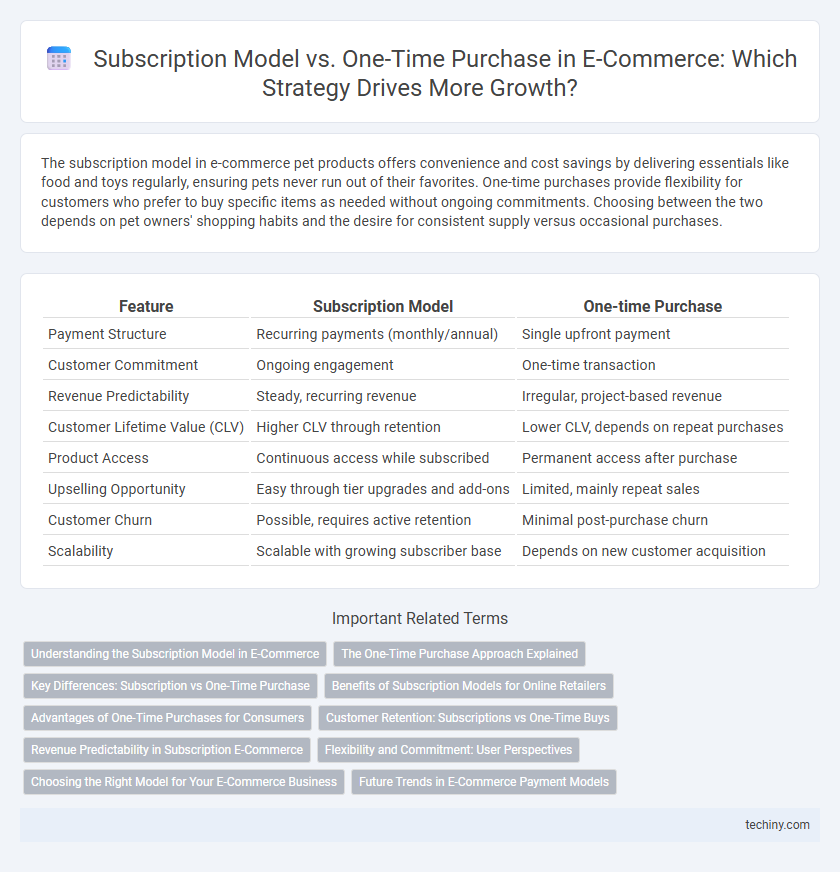The subscription model in e-commerce pet products offers convenience and cost savings by delivering essentials like food and toys regularly, ensuring pets never run out of their favorites. One-time purchases provide flexibility for customers who prefer to buy specific items as needed without ongoing commitments. Choosing between the two depends on pet owners' shopping habits and the desire for consistent supply versus occasional purchases.
Table of Comparison
| Feature | Subscription Model | One-time Purchase |
|---|---|---|
| Payment Structure | Recurring payments (monthly/annual) | Single upfront payment |
| Customer Commitment | Ongoing engagement | One-time transaction |
| Revenue Predictability | Steady, recurring revenue | Irregular, project-based revenue |
| Customer Lifetime Value (CLV) | Higher CLV through retention | Lower CLV, depends on repeat purchases |
| Product Access | Continuous access while subscribed | Permanent access after purchase |
| Upselling Opportunity | Easy through tier upgrades and add-ons | Limited, mainly repeat sales |
| Customer Churn | Possible, requires active retention | Minimal post-purchase churn |
| Scalability | Scalable with growing subscriber base | Depends on new customer acquisition |
Understanding the Subscription Model in E-Commerce
The subscription model in e-commerce offers customers recurring product or service deliveries for a fixed fee, ensuring steady revenue streams and improved customer retention. This model leverages data analytics to personalize offerings, optimize inventory management, and enhance customer lifetime value. Businesses adopting subscriptions benefit from predictable cash flow, reduced churn rates, and opportunities for upselling through customized subscription tiers.
The One-Time Purchase Approach Explained
The one-time purchase approach in e-commerce involves customers making a single payment to own a product outright, without recurring charges. This model appeals to buyers seeking immediate ownership and simplicity, typically favored for products with long-term use or less frequent updates. It offers businesses a straightforward revenue stream but may require more effort to maintain consistent sales compared to subscription models.
Key Differences: Subscription vs One-Time Purchase
Subscription models generate recurring revenue by charging customers at regular intervals, offering ongoing access to products or services, while one-time purchases provide a single transaction with lifetime ownership or usage rights. Key differences include customer retention strategies, cash flow predictability, and inventory management, where subscriptions require continuous fulfillment and one-time purchases involve sporadic demand. Subscription models often increase customer lifetime value (CLV) and facilitate personalized marketing, whereas one-time purchases emphasize immediate profit and simple transaction processes.
Benefits of Subscription Models for Online Retailers
Subscription models provide online retailers with predictable recurring revenue streams that enhance cash flow stability and financial planning. They foster increased customer lifetime value through continuous engagement and personalized experiences, reducing churn rates and boosting loyalty. Data collected from subscriptions enables retailers to refine product offerings and marketing strategies, driving higher conversion rates and sustained growth.
Advantages of One-Time Purchases for Consumers
One-time purchases offer consumers full ownership without recurring fees, providing clear cost predictability and immediate access to products. This payment model suits buyers who prefer to avoid long-term commitments and control their spending upfront. Consumers also benefit from fewer subscription management hassles, reducing the risk of unexpected charges and contract obligations.
Customer Retention: Subscriptions vs One-Time Buys
Subscription models enhance customer retention by providing recurring value and fostering long-term engagement, leading to predictable revenue streams and improved lifetime customer value. One-time purchases often result in sporadic interactions, requiring continuous acquisition efforts to maintain sales volume. E-commerce businesses benefit from subscriptions through increased loyalty, data collection for personalized experiences, and reduced churn rates compared to one-time purchase strategies.
Revenue Predictability in Subscription E-Commerce
Subscription models in e-commerce provide enhanced revenue predictability by generating consistent, recurring income streams compared to one-time purchases, which rely on irregular customer transactions. This consistent cash flow enables more accurate forecasting, inventory management, and strategic planning, reducing financial uncertainty. Businesses leveraging subscription services often experience higher customer lifetime value and improved retention rates, further stabilizing revenue projections.
Flexibility and Commitment: User Perspectives
Subscription models in e-commerce offer users enhanced flexibility through regular product delivery and customizable plans, catering to evolving needs without repeated purchases. One-time purchases provide low commitment, allowing consumers to buy without ongoing obligations, ideal for irregular or trial use. User perspectives often weigh the convenience and cost-effectiveness of subscriptions against the autonomy and simplicity of one-time transactions.
Choosing the Right Model for Your E-Commerce Business
Choosing the right sales model for your e-commerce business hinges on analyzing customer behavior, product type, and revenue goals. Subscription models drive consistent, predictable income and enhance customer loyalty by offering convenience and ongoing value, ideal for consumables or digital services. One-time purchases suit products with irregular demand or high customization, maximizing upfront revenue and appealing to customers seeking immediate ownership without ongoing commitments.
Future Trends in E-Commerce Payment Models
Subscription models in e-commerce are rapidly gaining traction due to their ability to generate predictable revenue streams and enhance customer retention through personalized experiences. One-time purchase frameworks continue to appeal for high-value or infrequent products but face challenges in sustaining long-term customer engagement. Emerging payment trends emphasize flexible subscription options combined with seamless, secure digital wallets and AI-driven payment analytics to optimize transaction efficiency and customer lifetime value.
Subscription Model vs One-time Purchase Infographic

 techiny.com
techiny.com